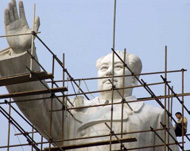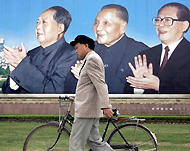Q&A: Mao and Maoism
Thirty years after the death of Mao Zedong what place does the former “Great Helmsman” hold in 21st-century China?

What is Maoism?
Maoism is a political ideology and interpretation of Marxism-Leninism – the philosophy that calls for the overthrow of capitalism and the leadership of a single party to guide the nation in the transition to communism.
The chief difference with Maoism is its emphasis on guerrilla warfare and the revolutionary potential of the peasantry, rather than the workers.
Maoist theory emphasises rural development and self-sufficiency and sees the peasantry as a force to be mobilised in a revolutionary people’s war. Hence, as with its origins in China, it has tended to be applied to developing world situations.
Groups beyond China which have labelled themselves as Maoist – such as in Nepal, India, Peru and the Philippines – have given prominence to the militant nature of political struggle.
What place does Maoism have in modern China?
 |
|
Officially Mao remains central to |
According to the Chinese constitution “Mao Zedong Thought”, as it is officially known, is the official doctrine of the Communist Party of China, and therefore of the Chinese state.
However, the definition of “Mao Zedong Thought” has been subject to extensive and radical revision in the 30 years since Mao’s death, mirroring China‘s changing policy directions as the country has opened up.
Mao remains widely revered – at least in official publications – as the founder of modern China, and his teachings are a central part of the school curriculum.
While the revolutionary posters portraying Mao as a virtual godlike figure have today largely been consigned to antiques markets and kitsch Mao-themed restaurants, his image remains a powerful symbol.
Mao’s face is on every Chinese banknote and large statues of Mao continue to be built, particularly on the fringes of the country seen as resistant to central government rule. A 35-tonne memorial is under construction close to the Tibetan capital, Lhasa.
What is the Chinese Communist Party’s line on Mao?
 |
|
Mao’s successors use him as a |
According to Deng Xiaoping – one of the original members of Mao’s revolutionary clique, who later fell victim to Mao’s purges – Mao was “70 per cent right and 30 per cent wrong”.
According to Deng, the initiator of China‘s market-oriented reforms after Mao’s death, Mao’s “contributions are primary and his mistakes secondary”.
This remains the philosophy of China‘s current leaders, overseeing the rapid transformation of the Chinese economy – a process they have dubbed “socialism with Chinese characteristics”.
For China’s leaders Mao is an important legitimising symbol justifying the Communist Party’s continued hold on power.
Maintaining popular respect for Mao is seen as central to maintaining respect for the party and, therefore, the unity and stability of the country.
How do ordinary Chinese view Mao today?
There are deep divisions over Mao’s relevance to modern China.
Many see him as a visionary and patriot who allowed China to become independent of what they see as foreign humiliation and put the nation on its rightful path to becoming a world power.
Others, particularly among the younger urban generation, view Mao as an historical figure of little relevance to the consumerist China of today.
Many older Chinese, however, irrespective of their views on the man himself, look back on Mao’s time as more egalitarian and less corrupt than China today.
And, while open discussion of such topics is frowned upon, many others undoubtedly view Mao as a tyrant who was responsible for the deaths of millions – either a result of violent political purges or through widespread famine.